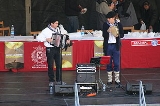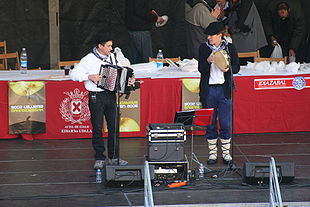
Trikitixa
Encyclopedia

Basque music
The strict classification of Basque music remains a controversial issue, complicated in part by the growing diversification of such music, but by and large it is made in the Basque Country, it reflects traits related to that society/tradition and it is devised by people from the Basque...
diatonic button accordion
Diatonic button accordion
A diatonic button accordion or melodeon is a type of button accordion where the melody-side keyboard is limited to the notes of diatonic scales in a small number of keys...
with right-hand rows keyed a fifth
Perfect fifth
In classical music from Western culture, a fifth is a musical interval encompassing five staff positions , and the perfect fifth is a fifth spanning seven semitones, or in meantone, four diatonic semitones and three chromatic semitones...
apart and twelve unisonoric bass buttons. The onomatopoeia trikiti, apparently stemming from the sound emitted by the tambourine
Tambourine
The tambourine or marine is a musical instrument of the percussion family consisting of a frame, often of wood or plastic, with pairs of small metal jingles, called "zils". Classically the term tambourine denotes an instrument with a drumhead, though some variants may not have a head at all....
, originally referred to a traditional Basque ensemble, made up of the instrument which now bears the name as well as alboka
Alboka
The alboka is a double hornpipe or clarinet native to the Basque Country.Although the alboka is a woodwind instrument, its name is derived from the Arabic "al-bûq"...
, txistu
Txistu
The txistu or chistu is a kind of fipple flute that became a symbol for the Basque folk revival. The name may stem from the general Basque word ziztu "to whistle" with palatalisation of the z...
and other instruments.
The trikiti's first written evidence is attested late in the 19th century, exactly in 1889, when diatonic accordion was used for music in a popular pilgrimage festivity of Urkiola (Biscay
Biscay
Biscay is a province of Spain and a historical territory of the Basque Country, heir of the ancient Lord of Biscay. Its capital city is Bilbao...
). In 1890, a trikiti appears in a picture taken in Altsasu (Navarre), a railway junction. Therefore some point to the instrument's import to the Basque Country
Basque Country (historical territory)
The Basque Country is the name given to the home of the Basque people in the western Pyrenees that spans the border between France and Spain on the Atlantic coast....
from Italy
Italy
Italy , officially the Italian Republic languages]] under the European Charter for Regional or Minority Languages. In each of these, Italy's official name is as follows:;;;;;;;;), is a unitary parliamentary republic in South-Central Europe. To the north it borders France, Switzerland, Austria and...
through the port of Bilbao
Bilbao
Bilbao ) is a Spanish municipality, capital of the province of Biscay, in the autonomous community of the Basque Country. With a population of 353,187 , it is the largest city of its autonomous community and the tenth largest in Spain...
, while other sources suggest that this kind of diatonic accordion was brought in by Italian or French railway workers from the Alps. The diatonic button accordion
Diatonic button accordion
A diatonic button accordion or melodeon is a type of button accordion where the melody-side keyboard is limited to the notes of diatonic scales in a small number of keys...
itself was devised in Vienna in 1829, expanding thereafter all over Europe.
The pair of diatonic button accordion
Diatonic button accordion
A diatonic button accordion or melodeon is a type of button accordion where the melody-side keyboard is limited to the notes of diatonic scales in a small number of keys...
along with tambourine
Tambourine
The tambourine or marine is a musical instrument of the percussion family consisting of a frame, often of wood or plastic, with pairs of small metal jingles, called "zils". Classically the term tambourine denotes an instrument with a drumhead, though some variants may not have a head at all....
gradually grew in popularity and was adopted to perform in local and popular festivities, where the young danced to its tunes (fandangos, arin-arin etc.), despite the Catholic church's resistance, who dubbed it "hell's bellows
Bellows
A bellows is a device for delivering pressurized air in a controlled quantity to a controlled location.Basically, a bellows is a deformable container which has an outlet nozzle. When the volume of the bellows is decreased, the air escapes through the outlet...
" on the grounds that its dance-inciting and lively music would lead Basque youths into temptation.
That playing pattern remained unchanged up to the 80s, when Kepa Junkera
Kepa Junkera
Kepa Junkera is a Basque musician and composer. A master of the trikitixa, the diatonic accordion, he has recorded more than 10 albums...
and Joseba Tapia started to develop unprecedented ways of playing trikiti. While both authors came in for much criticism for their novelties and experimenting, they caught on and both styles, traditional and modern trikiti, have found their way and consolidated their separate paths. Both performers remain nowadays key figures of trikiti accordion. There have been influences of Tejano
Tejano music
Tejano music or Tex-Mex music is the name given to various forms of folk and popular music originating among the Mexican-American populations of Central and Southern Texas...
artists like Flaco Jiménez
Flaco Jiménez
Leonardo "Flaco" Jiménez is a Tejano music accordionist from San Antonio, Texas. Jiménez's father, Santiago Jiménez Sr. was a pioneer of conjunto music. He began performing with his father at age seven and recording at age fifteen, as a member of Los Caporales...
and other international players. Other renowned players include Iñaki Malbadi, Maixa Lizarribar, Alaitz Telletxea, Iker Goenaga or the Catalan Carles Belda.
Currently traditional style ensembles consist of a pair playing trikiti (diatonic button accordion
Diatonic button accordion
A diatonic button accordion or melodeon is a type of button accordion where the melody-side keyboard is limited to the notes of diatonic scales in a small number of keys...
), tambourine
Tambourine
The tambourine or marine is a musical instrument of the percussion family consisting of a frame, often of wood or plastic, with pairs of small metal jingles, called "zils". Classically the term tambourine denotes an instrument with a drumhead, though some variants may not have a head at all....
and voice. Players typically use a highly-ornamented and swift style, along with staccato
Staccato
Staccato is a form of musical articulation. In modern notation it signifies a note of shortened duration and separated from the note that may follow by silence...
triplets.

